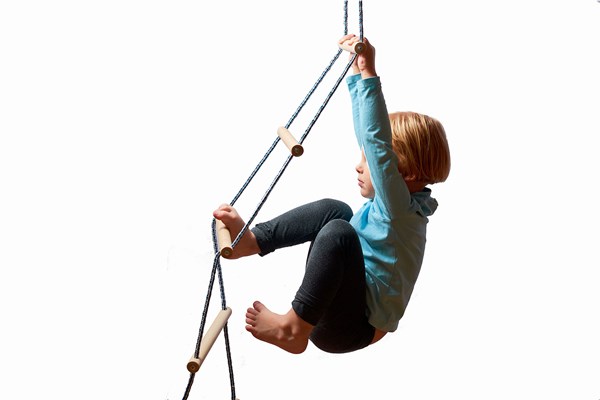Risky Play and Risk Assessments
Risky Play
Sandsetter (2009) defines ‘Risky Play’ as “thrilling and exciting forms of play that involve a risk of physical injury”. Risky Play requires adults to accurately support children, knowing their current capabilities and having the confidence to allow them to take a measured risk. It requires a skilful adult to make judgement calls instinctively based on each child’s abilities.
In recent years, the pandemic has affected children’s opportunities for risky play. Places where children might commonly engage in risky play (such as soft play centres and playgrounds) were closed for significant amounts of time. Furthermore, some parents are less confident to let their children take part in play which might hold a risk of injury or infection. An Ofsted report into the impact of lockdown and Covid-19 on EYFS aged children found that some children had not experienced outdoor play at all during the first lockdown period (Ofsted 2020).

Part of young children’s learning and development is exploring their critical thinking, self-regulation and autonomy skills in relation to keeping themselves safe. Children need and instinctively want to be able to take risks, testing their capabilities and strengths. Risky play allows children to challenge themselves on many levels and work towards these skills. Benefits include:
- Physically – by climbing a little higher, running a little faster or jumping a little further
- Emotionally – feeling out of control or overcoming fear
- Mentally – learning how to get out of trouble, learning personal boundaries and becoming familiar with the environment around them
A lot of boundaries we put in place directly relate to the fear adults have over children hurting themselves, unintentionally limiting the opportunities provided to children. The HSE publication ‘Children’s Play and Leisure; A Balanced Approach to Play’ may be helpful for many settings in supporting staff and parents to see the benefits of risky play.
When creating a safe environment, adults working with children must consider their legal duty to identify and reduce risks wherever possible. However, this does not mean to keep every wall padded and every resource soft just so children do not injure themselves! Measured risks allow children to challenge themselves and learn new skills. As part of their learning and development, children need the support of adults around them to take these risks and gain the rewards which accompany risky play.
For example, the risk of falling off larger play equipment is significant while children are still assessing their abilities against the equipment they are using. The risk of harm could be minimised, however, by ensuring that there is adequate supervision, correct positioning of the equipment away from windows or walls, appropriate landing materials on the ground, no overcrowding and pre-agreed “rules” in accordance with individual children’s level of understanding. These safety measures mean the risk of injury is reduced and if an incident was to occur it would be reduced in severity.
Leaders and managers should ensure that their staff team have the skills and knowledge to safely supervise any activities considered risky and that they know their children well enough to accurately support them. First Aiders should always be nearby to risk play activities along with a correctly-stocked first aid kit. On occasion it might be beneficial to explain the risks to children in advance and provide them with information on how to keep themselves safe.

Risk Assessments
Employers are required by law to protect their employees, and others, from harm. Under the Management of Health and Safety at Work Regulations 1999, the minimum they must do is:
- identify what could cause injury or illness in the business (hazards)
- decide how likely it is that someone could be harmed and how seriously (the risk)
- take action to eliminate the hazard, or if this isn't possible, control the risk
Paragraph 3.65 of the Statutory Framework for the EYFS states “…Risk assessments should identify aspects of the environment that need to be checked on a regular basis, when and by whom those aspects will be checked, and how the risk will be removed or minimised.”
Many people end up in the cycle of writing risk assessments as a formality and then not using this again until it’s time to review. Instead, risk assessments should be dynamic ongoing documents which all users are aware of and can potentially contribute to. It can be helpful for them to be in writing but not essential for all risk assessments. The HSE does state that companies which employ over 5 people must put their risk assessments in writing. If selecting to put a risk assessment into writing, there is no specific format to use. It is down to each provision to find the most effective yet user-friendly format that works for their provision. The HSE provides specific guidance for education settings on managing significant risks. Early Years would likely be best fit within the ‘schools’ section.
Risk assessments should consider long-term safety, such as electrical and fire safety procedures. They might stipulate who is responsible for checking these aspects and when they are due. The risk assessment may identify areas of risk on every-day items, such as protecting children’s fingers from being caught in door hinges/openings or ensuring children do not have access to cleaning chemicals. Individual risk assessments may be required for short-term risks, such as a staff or child coming in with a broken bone or recovering from serious injury, pregnancy or even building works taking place on site.
When considering risk assessments in relation to food, on 1st October 2021 ‘Natasha’s Law’ came into effect. This relates to the requirements for labelling pre-packed foods for direct sale (PPDS) in England, Wales and Northern Ireland. Any food business that produces PPDS food will be required to label it with the name of the food and a full ingredients list. Allergenic ingredients must be emphasised within this list. These changes help protect consumers, by providing potentially life-saving allergen information on packaging. This legislation applies to any food business that produces PPDS food, which may include schools, colleges, universities, and early years settings.
For most early years settings, PPDS will not be prepared on site and this new requirement will not be applicable. However, the Food Standards Agency (FSA) have produced detailed guidance for education settings, including nurseries, on what food is classed as PPDS and what should be included on the food label.
Sources and additional information:
- Ellen Beate Hansen Sandseter (2009) Characteristics of risky play, Journal of Adventure Education and Outdoor Learning, 9:1, 3-21, DOI: 1080/14729670802702762
- Department for Education (2021) Statutory framework for the early years foundation stage. Available at: https://www.gov.uk/government/publications/early-years-foundation-stage-framework--2
- https://www.hse.gov.uk/services/education/index.htm
- ‘Children’s Play and Leisure; A Balanced Approach to Play’
- Ofsted (2020) Covid-19 series: Briefing on early years, October 2020
- https://www.food.gov.uk/business-guidance/prepacked-for-direct-sale-ppds-allergen-labelling-changes-for-schools-colleges-and-nurseries